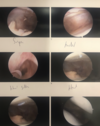Case 11 Flashcards
(8 cards)

Initial patient visit–Patient is a 26-year-old man who sustained a left knee injury after being involved in a motor vehicle accident where he would characterize dashboard injury with direct trauma to his left knee. Initially sought care in the emergency room where is treated release. He then follow-up quickly with his primary care doctor left knee pain with feeling of instability and referred to orthopedics for concern of an ACL tear. I
n the office when I evaluate him I was concerned about ACL tear so I ordered an MRI prescribed conservative management such as anti-inflammatories and therapy and work restriction.
We went under shelter in place during his work-up so his care was altered.

Left knee examination upon initial inspection was concerning for meniscal pathology. There is no obvious deformity noted. No previous scars. There is no tenderness upon palpation throughout the patellar tendon region and in the patella, but with primarily medial and lateral joint line tenderness. I appreciate a subtle effusion. Passive Range of Motion is 0-140 degrees and active is 0-140 degrees. Strength assessment is 5/5 in the quadriceps, 5/5 in the hamstrings. Negative anterior and posterior drawer exam. Negative Lachman exam. Stable to Varus and Valgus stress testing. Positive McMurray´s exam. Pain is recreated with deep knee flexion Positive Apley compression test.


Imaging review
Labs
Pre-op labs
Medical Review
Covid Testing

MRI was most notable for a lateral discoid meniscus, absence of any ligamentous or additional meniscal tear. He did see with the serial 3 cuts he meets criteria for discoid meniscus.
Noticed on the AP meniscus is 15 mm, and here are 3 serial cuts with bowtie appearance.
series of three images with discoid meniscus


Surgical decision-making is unique in this situation as there was a state wide ban on urgent surgeries in Massachusetts secondary to Covid. Moreover we did extensive risk mitigation and selecting patients would be safe to return back to the operating room.
This required chief of surgery approval. In addition reclassified urgent cases as difficulty with working or persistent functional loss. As such this patient qualified to be one of the first patient is to return to the operating room as he was medically healthy, indicated for minimally invasive proceed and would be an outpatient procedure.
Indication for surgery this patient will be a traumatic etiology with persistent mechanical type symptoms, physical exam concerning for meniscal type pathology, and MRI that is concordant for what may be a symptomatic discoid meniscus, and failure to return back to normal activities including ability to work.

The differential diagnosis for this was most likely a symptomatic discoid meniscus that would be amenable to saucerization. We would also be prepared for meniscal repair as well.
In addition we will evaluate for a symptomatic plica, fat pat impingement or chondral lesion, or ligamentous instability that was occult.

Identified and unstable chondral flap the medial femoral condyle that was amenable to chondroplasty.
Using both a straight biter and a rotary shaver I debrided to a stable rim.


I then completed the diagnostic arthroscopy without any additional pathology identified. Duration of surgery was 25 minutes with 10cc estimated blood loss.
Patient was discharged with multimodal pain meds, limited narcotics, aspirin and ice/crutches, WBAT, routine knee arthroscopy protocol.
Patient general postop course was uncomplicated. I saw him at 2 weeks, 6 weeks, 3 months and 4 months which is consistent with my routine recovery program. My last follow-up visit was approximately 9 months status post surgery and he is generally doing well.


